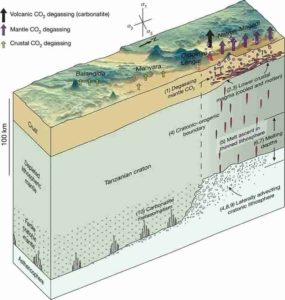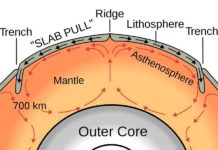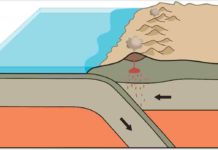
University of New Mexico (UNM) Professor of Earth and Planetary Sciences, Dr. Tobias Fischer and Syracuse University research fellow (now University of Auckland Lecturer), Dr. James Muirhead led an international team of interdisciplinary researchers to investigate the role of carbon in the break-up of continents.
This work, much of which has been funded by grants from the National Science Foundation, is a culmination of research efforts that started with former students from UNM and other US, French, Tanzanian and Kenyan universities.
The collaboration, which also included scientists from New Mexico Tech, the University of Oregon, University of Dar Es Salaam, Seoul National University, University of Tokyo, University of Alberta, Macquarie University, Goethe University and Université de Montpellier II, led to new insights into the storage and dynamic transfer of carbon below thick and very old continental crust currently published in the journal Nature titled, Displacement of cratonic mantle and lithospheric channeling concentrates deep carbon during continental rifting.
It was first recognized by former UNM student, now assistant professor at Seoul National University, Dr. Hyunwoo Lee, that the East African Rift and continental rifts in general are significant sources of carbon degassed from the Earth’s mantle to the atmosphere. While later work by other groups showed that CO2 emissions from the East African Rift are variable along its 3,000 km extent, the question remained “where does all this carbon come from and how is it so efficiently released?”
Subsequent work by Fischer and collaborator Professor Stephen Foley from Macquarie University, Australia, proposed a model in which the degassing CO2 is ultimately sourced from carbon that has accumulated over billions of years at the base of the thick old cratonic lithosphere located in the center and edge of the East African Rift.
“The model suggests that this accumulated carbon originates from subducting oceanic plates and deep mantle plumes,” said Fischer. “These processes could deliver sufficient carbon to the bottom of very thick and billion year old continental lithosphere to explain the high CO2 fluxes observed in the actively deforming part of the rift.”
However, the model proposed by Fischer and Foley could not explain how this deep CO2 managed to leak out from the actively extending part of the rift, which is exactly where the current work connects the dots.
Muirhead and Fischer together with Master’s student Amani Laizer from University of Dar Es Salaam in Tanzania and geophysics Ph.D. student Sarah Jaye Oliva from Tulane University returned to Tanzania in 2018 and collected data and samples in locations where active rifting,
i.e. where the plates move apart, intersect the old thick craton that lies above a mantle plume. Gas samples were collected from hot springs in this region that have never been sampled before.
The analyses of these samples within the context of already existing data from the earlier work showed a striking difference in chemical composition of the gases that are released from the active rift and the craton. Craton gases are entirely crustal with no sign of any mantle gases, including CO2. Nitrogen and crustal helium dominate these craton gases. Rift gases on the other hand are stuffed with mantle CO2 and have a strong mantle helium isotope signature. Measured mantle CO2 fluxes are close to zero on the craton but surge in the adjacent actively extending rift.
“Right at the boundary between the craton and the deforming rift sits the world’s only currently erupting carbonatite volcano, Oldoinyo Lengai,” said Fischer. “This volcano erupts lavas that are so liquid they move like motor oil. The reason for this is that they are devoid of the silica that makes up most igneous rocks but contain about 30 percent carbon, a staggeringly high amount that gives the rock its name carbonatite. Looking back in geologic time, it turns out that there are many carbonatite volcanoes right at the edge of the Tanzania craton, but they are just not currently active.”
This distribution of carbonatites led the team to propose a mechanism that causes the lateral migration of the deep cratonic lithosphere where all that stored solid carbon is located, into the mantle at the edges of the craton.
Geophysical data acquired and analyzed by Tulane University and Université de Montpellier II image a steep step in plate thickness at the craton edge. The geophysicists led by Professor Cindy Ebinger, Drs. Sarah Oliva and Professor Christel Tiberi proposed that this step enhances formation of melt and explains the concentration of magma that carries the excess CO2, as well as the spatial distribution of sometimes damaging earthquakes that open cracks for the CO2 to rise to the surface. This would explain the striking difference in CO2 release and source as documented by the surface measurements.
This conceptual model also fits into quantitative physical models developed by Dr. Jolante van Wjik, professor at New Mexico Tech and Dr. Claire Currie, professor at University of Alberta, which shows that unusually thick and low density mantle rocks beneath a craton will be swept laterally by mantle flow, moving toward the thinner plate beneath the continental rift.
This material transfer may enhance melt production. Therefore, the research team concluded, lateral migration of deep cratonic lithosphere soaked with ancient accumulated carbon is ultimately responsible for carbonatite volcanism and the on-going continental break-up in this region of East Africa.
Reference:
Muirhead, J.D., Fischer, T.P., Oliva, S.J. et al. Displaced cratonic mantle concentrates deep carbon during continental rifting. Nature, 2020 DOI: 10.1038/s41586-020-2328-3
Note: The above post is reprinted from materials provided by University of New Mexico. Original written by Steve Carr.










